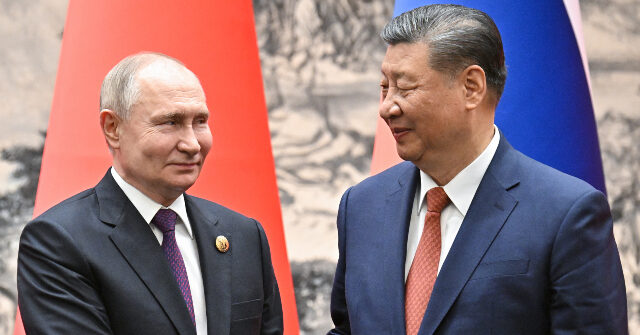The Australian Strategic Policy Institute (ASPI) and Radio Free Europe (RFE) published research on Friday that shows Chinese defense universities have greatly increased their cooperation with Russian institutions, creating a pipeline for Russia to obtain technology and expertise that should be blocked by sanctions against Russia’s invasion of Ukraine.
ASPI and RFE reported that China has 68 universities officially linked to its military-industrial complex, and all of them have “deepened or dramatically deepened” their ties with Russian institutions since 2019.
“These are all universities tied to defense or the critical and dual-use technology ecosystem in China. This could indirectly aid Russia’s war in Ukraine by providing access to innovations and know-how that help offset Western sanctions and export controls,” ASPI head of China investigations Bethany Allen told RFE.
China and Russia declared a “no-limits partnership” in 2022, shortly before Russian President Vladimir Putin ordered the invasion of Ukraine, and they have publicly reaffirmed this partnership several times in the years since then.
According to ASPI’s research, cooperation on defense research between China and Russia accelerated dramatically after the Ukraine invasion began. Much of this cooperation involved dual-use technology with both civilian and military applications.
Sometimes Russian technology proved helpful to China, as in the field of aircraft engines, where Russian assistance could help China take the lead on cutting-edge technology away from the United States. China historically has trouble producing top-quality aircraft engines, so Russia’s assistance is invaluable.
Some of the partnerships are quite clearly linked to Russia’s war in Ukraine. One example cited by ASPI is the Peter the Great St. Petersburg Polytechnic University, which launched a joint training program in 2023 with Xi’an Technological University, one of China’s most important defense technology schools. The Russian university is deeply involved in the Ukraine war, especially in the crucial field of drone warfare, and China is helping it get around tough U.S. and European Union sanctions.
“Russia finds itself cut off from Western scientific research to some extent after the invasion of Ukraine and Chinese research institutes are also facing new restrictions, particularly from the United States. Against that pressure, they’ve decided it makes sense to cross-pollinate,” Allen told RFE.
In June, the Center for European Police Analysis (CEPA) said Chinese-Russian cooperation has been skating just beneath the level of a full-blown military alliance.
CEPA observed that Russia lost a great deal of military and industrial strength when it alienated Ukraine by annexing Crimea in 2014. The Russians quickly set about replacing what they lost by developing partnerships with China, paying for Beijing’s help with “missile, air defense, and electronic technology.”
“As of early 2025, Beijing was a crucial, irreplaceable enabler of Russia’s sustained war efforts against Ukraine,” CEPA declared.
China carefully keeps this relationship limited and obscured in certain respects because it is “unwilling to limit its own strategic autonomy and freedom of maneuver by making any commitment to Russia that would lead to an open conflict with the West or the introduction of sanctions.”
The Strategic Studies Institute (SSI) at the U.S. Army War College said in September 2024 that China leaped at the chance to strengthen its military capabilities by absorbing Russian technology after the invasion of Ukraine. Beijing shrewdly realized that Russia would give away its military tech at fire-sale prices in order to obtain “diplomatic support and a crucial economic lifeline” from China.
“Russia is helping China to build a missile attack early warning system, and the two countries are engaged in the joint development of heavy-lift helicopters, conventional attack submarines, and missiles,” SSI said, warning that the greatest potential threat could be China obtaining Russian submarine technology.
Read the full article here


